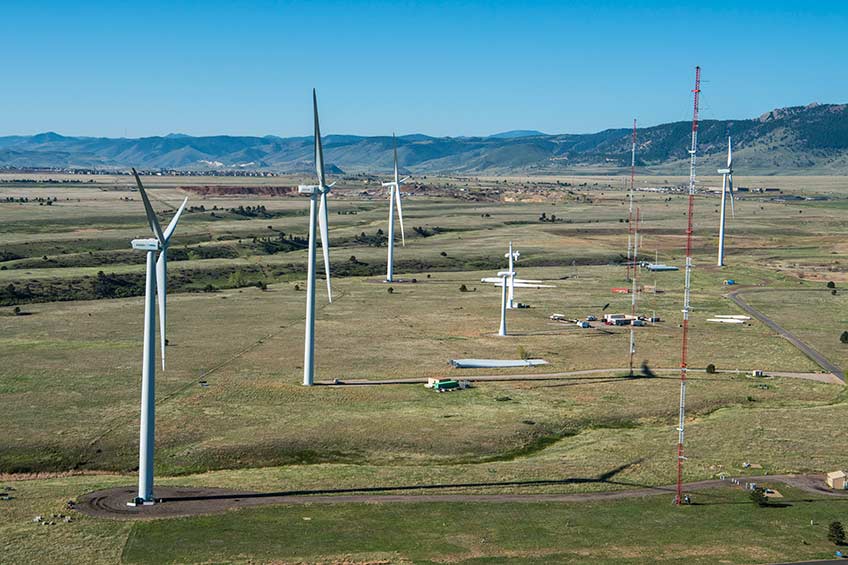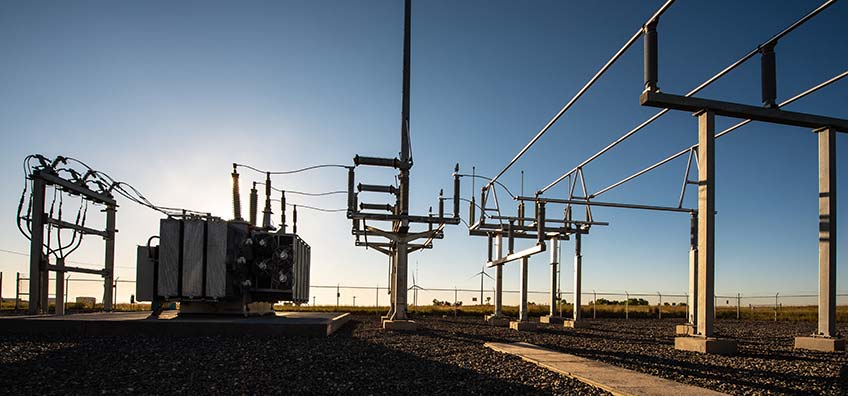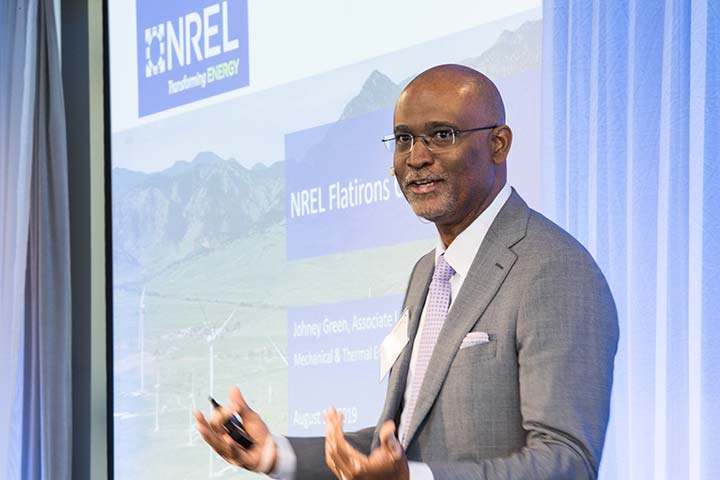The Leading Edge: December 2020 Wind Energy Newsletter
In this edition, we reflect on 2020 and NREL's activities that help drive wind innovation for a more sustainable future.
News Stories
NREL's Top 2020 Wind Program Accomplishments Demonstrate a Clear Vision for Wind Energy Advancement
As 2020 draws to a close, we look back on some of NREL's top wind program accomplishments of the year. From developing new tools to advance offshore wind deployment to helping prepare and connect the wind workforce of the future, these accomplishments demonstrate a clear vision for wind energy progress guided by the laboratory's scientific and research abilities.

Offshore Wind Industry Prepares To Ride Economic High Tide
The U.S. offshore wind energy pipeline is predicted to exceed 25,000 megawatts (MW) by 2030. Developers need accurate modeling to evaluate prospective projects, weigh realistic costs against financial returns, anticipate the impact of technological and process innovations, and quantify risk factors.
National Wind Technology Center researchers at NREL use a wide range of modeling expertise and tools to help industry, government, and research partners gain a crucial, objective understanding of the balance among potential offshore wind costs, revenues, and risks within the broader context of technical, legal, regulatory, tax, and policy issues.
NREL Advanced Manufacturing Research Moves Wind Turbine Blades toward Recyclability
A new material for wind blades that can be recycled could transform the wind industry, making renewable energy more sustainable than ever before while lowering costs.
Researchers at NREL, in partnership with Arkema Inc. of Pennsylvania, have demonstrated the feasibility of thermoplastic resin and validated its structural integrity on a thermoplastic composite blade manufactured at NREL.
Offshore Wind Power Plant Optimization Boosts Performance, Reduces Costs
NREL researchers are taking a plant-level, systems-engineering approach to maximize offshore wind systems' energy output, life span, and economic feasibility while minimizing forces on individual wind turbines. The laboratory's wind power plant optimization work, in collaboration with academic and industry partners, develops the methods and tools to make plant-level control with wake steering a reality, further augmenting gains from optimized wind turbine layouts.
ARIES Microgrid Infrastructure Powers NREL Campus through Outage
Less than 2 months after NREL commissioned utility-scale infrastructure for the Advanced Research on Integrated Energy Systems (ARIES) research platform, the Flatirons Campus experienced a utility-scale emergency: an outage that cut power to the entire site, including its servers, offices, and research hardware.
Despite the setback, the ARIES microgrid research platform demonstrated how renewable microgrids of the future can be used to restore power.

Downwind: In Case You Missed It
Supersized Wind Turbines Generate Clean Energy and Surprising Physics
Science News covered recent efforts to study the fluid dynamics challenges influencing wind turbine power output, especially as wind turbine towers grow taller and their rotors wider. NREL Chief Engineer Paul Veers underscored the need to study and understand these dynamics across all scales, identifying an existing gap in our understanding of how giant wind power plants with larger, but fewer, turbines operate.

Scientific Organization Names NREL's Green a Fellow
Johney Green, an associate laboratory director at NREL, has been named a fellow of the American Association for the Advancement of Science. The world's largest general scientific society, the American Association for the Advancement of Science annually elevates as fellows those members whose "efforts on behalf of the advancement of science, or its applications, are scientifically or socially distinguished."
Publications
Multifaceted Drivers for Onshore Wind Energy Repowering and Their Implications for Energy Transition
This Nature Energy article proposes a more holistic and socially informed project-level approach for analyzing repowering—the combined activity of dismantling or refurbishing and commission of wind turbines. Through an analysis of repowering efforts in Denmark, researchers found that only 67% of the capacity removed in repowering projects was related to the physical space needed for a new turbine. Other factors that drive repowering include regulation, development principles, and political bargaining. Such findings recognize repowering as a negotiated process between host communities and wind developers and a crucial element for unlocking the full potential of wind energy as part of the world's energy transition.
The Cost of Floating Offshore Wind Energy in California between 2019 and 2032
NREL published a study that provides site-specific cost and performance data for floating offshore wind. Designed to inform California's long-term energy planning, the analysis focused on five geographically dispersed study areas that represent regions where offshore wind has development potential. The study estimates that the levelized cost of energy from offshore wind could decrease an average of 44% between 2019 and 2032, reaching levels of $53–$64/MWh.
Comparison of Modular Analytical Wake Models to the Lillgrund Wind Plant
This validation study reviews the underlying theory for analytical wake models, outlines quality control procedures for observational data, and compares model results with observational data from the Lillgrund Wind Plant in Sweden. The researchers found that velocity deficit models that account for flow conditions in the near wake are better able to reproduce power production for wind turbines in the transitional region of the wind plant, whereas in the deep array, wake-superposition schemes become the largest driver in error reduction.
Does the Rotational Direction of a Wind Turbine Impact the Wake in a Stably Stratified Atmospheric Boundary Layer?
This journal article investigates the relationship between wind turbine rotor rotation and wind inflow profiles and the resulting impacts on wind turbine wakes. Veering profiles, or increases of wind direction with height, are common in nighttime conditions in the Northern Hemisphere. Using large-eddy simulations, the research team evaluated combinations of rotor rotation and inflow wind conditions and found that in veering conditions, the direction of rotor rotation can change the behavior of the wake. In some circumstances, the near wake will rotate in a different direction from the far wake. The physical mechanism responsible for this difference can be explained by a simple linear superposition of a veering inflow with a Rankine vortex.
FAST.Farm Development and Validation of Structural Load Prediction against Large-Eddy Simulations
Developed by NREL, FAST.Farm is a midfidelity engineering tool designed to accurately and efficiently predict wind turbine power production and structural loading in wind farm settings, including wake interactions between turbines. This study aims to quantify the ability of FAST.Farm to accurately predict turbine structural response in a small wind farm. Overall, study results establish confidence for applying FAST.Farm to wind farm power and loads analyses and for identifying areas where further model validations and model improvements should be conducted.
Operational-Based Annual Energy Production Uncertainty: Are Its Components Actually Uncorrelated?
Accounting for uncertainty when calculating annual energy production helps quantify risk and determine financing terms. A popular industry practice is to assume that different uncertainty components within an annual energy production calculation are uncorrelated and can therefore be combined as the sum of their squares. In this journal article, NREL researchers assess the practical validity of this assumption for operational-based uncertainty by performing operational annual energy production estimates for more than 470 U.S. wind plants. Based on their results, the researchers conclude that correlations between the identified uncertainty components should be considered to more accurately assess the total annual energy production uncertainty and propose a methodological framework to do so.
The Importance of Weather and Climate to Energy Systems: A Workshop on Next-Generation Challenges in Energy-Climate Modeling
Recently, power system operations and energy system planning have shown a growing appreciation of the risks posed by climate variability, change, and uncertainty. To address these risks, more than 80 international weather, climate, and energy systems researchers joined two online sessions to highlight and prioritize ongoing and future challenges in energy-climate modeling. This report summarizes the workshop, which had two primary goals: to build deeper engagement across the "energy" and "climate" research communities and to identify and begin to address the scientific challenges associated with modeling climate risk in energy systems.
Planning is underway for a follow-up workshop in summer of 2021. Please contact Julie Lundquist if you are interested in participating.
Validating Simulated Mountain Wave Impacts on Hub-Height Wind Speed Using Sodar Observations
Predicting the details of mountain waves events can be valuable for the wind energy community because mountain waves triggered as air moves over mountain barriers can impact wind power generation over areas where these mountain waves occur.
This journal article investigates the ability of the Weather Research and Forecasting model to simulate mountain waves and their impact on hub-height wind speed. The research found that the Weather Research and Forecasting model has moderate skill in simulating observed mountain waves and, for the simulated cases, consistently predicts impacts of significant mountain wave events about an hour earlier than the actual observations.
Share

